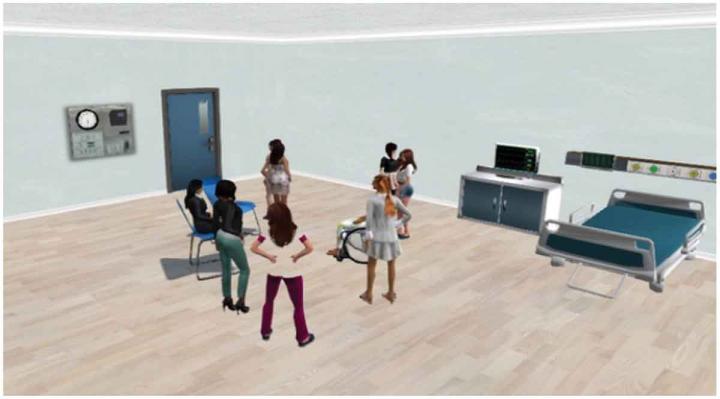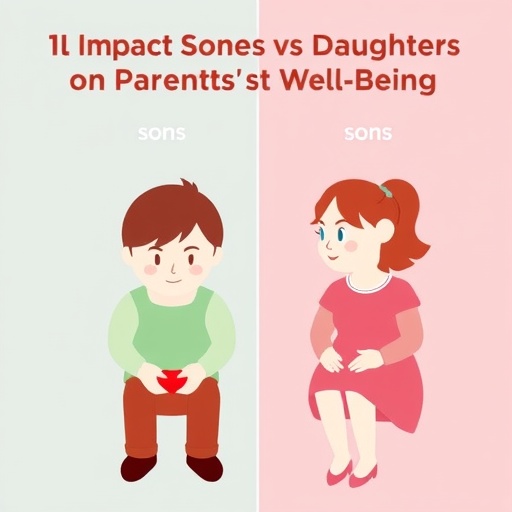A new study says a simulated educational experience has the potential to enable convenient and effective interprofessional education in palliative care for health professions students

Credit: Image reprinted by permission of Taylor & Francis Ltd
BOSTON (Oct. 3, 2019)–A virtual world may be a feasible learning platform for bringing together students from different healthcare professions and enhancing their understanding of collaborative patient care and knowledge of other health professions, according to a pilot study led by researchers from Tufts University School of Medicine and published online in the Journal of Interprofessional Care.
Interprofessional education (IPE) aims to foster learning and collaboration among healthcare students from different professions, with a goal of enhancing patient care. Scheduling face-to-face learning between students in different programs, however, is one of the largest barriers to implementing this type of learning. The study evaluated a virtual educational environment for its ability to provide IPE in palliative care, which is interdisciplinary by nature.
“IPE is an incredibly valuable experience for health professions students to have, and collaborative team-based palliative care has been shown to have a real impact on improving quality of life and patient care while lowering healthcare costs,” said first and corresponding author Amy L. Lee, an assistant professor of family medicine at Tufts University School of Medicine. “Interprofessional learning is a crucial component for health professions training, but it’s often easier said than done. Challenges aligning students’ schedules to physically meet and work together are the most-commonly cited obstacle. Communication in real-time via a virtual setting might help address this problem.”
Palliative care is multidisciplinary team-based medical care focused on the patient’s needs and quality of life during a serious illness. Teams of doctors, nurses, social workers and other caregivers work together to provide the patient, family, and other doctors treating the patient with medical, emotional, and logistical support.
The researchers created an IPE palliative care experience in the virtual reality platform Second Life. Thirty-five graduate-level health professions students enrolled in two-hour online educational sessions at their own convenience, creating groups of three-to-six students from different professions and in multiple geographic locations. Students came from five professions: nursing, medicine, nutrition, physical therapy, and social work.
The virtual reality world included three team activities that students participated in by using an avatar, a digital representation of themselves. The first activity was a team scavenger hunt, where participants communicated over audio and group-text messaging and had to move together as a team from one location to the next. This allowed the team members to work together as they learned how to use the technology of the virtual world. Following the scavenger hunt they went to an exam room for a conversation with a standardized patient and her family member about symptom management and palliative care options; here they interacted with the patient and her sister over live audio while also silently consulting one another over group-text. The researchers even developed a virtual representation of the patient’s experience, allowing the students to better understand their patient. The final component was a debrief about the virtual reality experience.
The researchers used a series of pre- and post-session surveys to assess how effective the virtual reality platform was at fostering palliative care collaboration between students. Students also submitted written reflections and photographs of their experience.
Overall, the researchers found that the virtual reality approach to interprofessional education was comfortable and convenient for students to take part in and improved student attitudes about the value of other healthcare professionals. Students reported appreciating the virtual experience of their patient’s symptoms, indicated by an increased sense of empathy on their post-session surveys, and the ability to practice anonymously and without worry about causing harm to a patient or making mistakes during the learning process. Some students also reported an interest in learning more about palliative care and continuing IPE training with their team–whether virtually or in real life–after the study.
In critical feedback, some students reported confusion with the unfamiliar platform and expressed that the lack of in-person communication and ability to observe body language cues were drawbacks to using virtual reality for simulated patient interactions.
“Students came away from this study with a number of important lessons, and we as educators also learned something about teaching team skills in a virtual environment,” said Lee. “While more studies are needed to understand the best ways to integrate this type of learning experience into degree program curricula, the virtual environment opens up a new possibility for removing some of the barriers to collaborative patient care.”
The researchers acknowledge that the participant group was small, and the voluntary nature of the study may have attracted students with interests in palliative care and virtual reality education.
###
Lee also practices family medicine at Greater Lawrence Family Health Center and its Lawrence Family Medicine Residency, an affiliate of Tufts University School of Medicine.
Additional authors on this study are Michelle DeBest, Rebecca Koeniger-Donohue, and Shelley R. Strowman, all School of Nursing, Simmons University; and Suzanne E. Mitchell, Boston University School of Medicine and Tufts University School of Medicine.
This work was supported by an Innovations in Education grant from Tufts University School of Medicine.
Lee, A.L., DeBest, M., Koeniger-Donohue, R., Strowman, S.R., Mitchell, S.E. (2019). The feasibility and acceptability of using virtual reality world technology for interprofessional education in palliative care: a mixed methods study. Journal of Interprofessional Care. Advance online publication. doi: 10.1080/13561820.2019.1643832.
Image from “The feasibility and acceptability of using virtual reality world technology for interprofessional education in palliative care: a mixed methods study,” by Amy L. Lee et al, published in Journal of Interprofessional Care. Reprinted by permission of Taylor & Francis Ltd.
About Tufts University School of Medicine
Tufts University School of Medicine is an international leader in medical and population health education and advanced research. It emphasizes rigorous fundamentals in a dynamic learning environment to educate physicians, scientists, and public health professionals to become leaders in their fields. The School of Medicine is renowned for excellence in education in general medicine, the biomedical sciences, and public health, as well as for research at the cellular, molecular, and population health level. It is affiliated with more than 20 teaching hospitals and health care facilities. Tufts University School of Medicine undertakes research that is consistently rated among the highest in the nation for its effect on the advancement of medical and prevention science.
Media Contact
Lisa LaPoint
[email protected]
Related Journal Article
http://dx.




